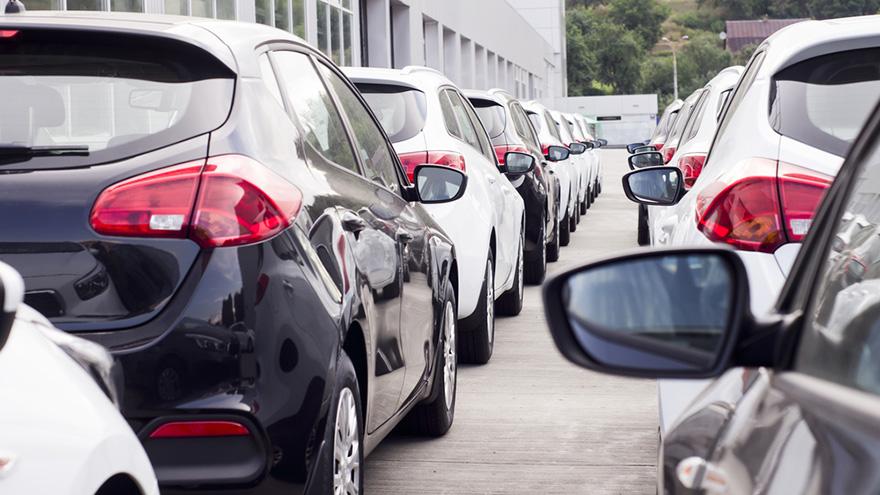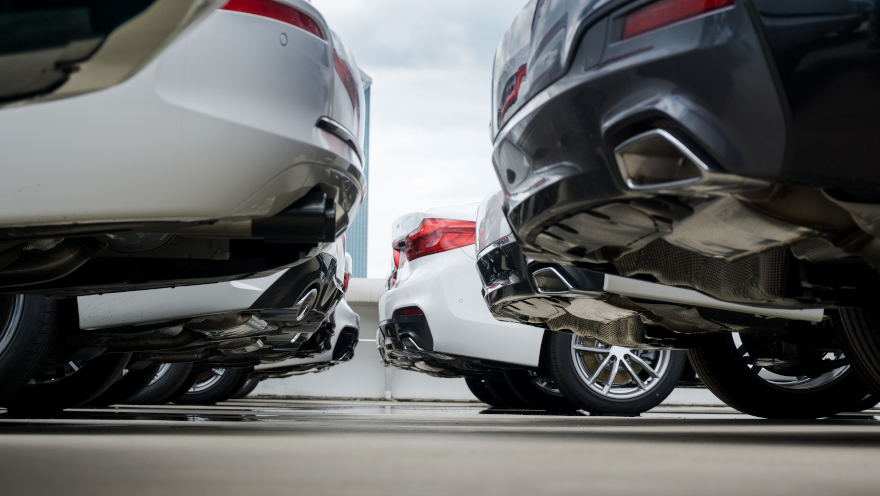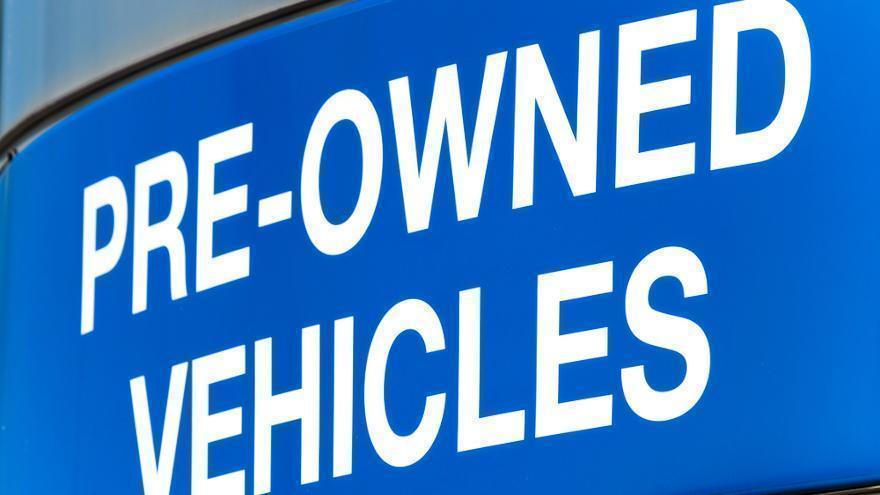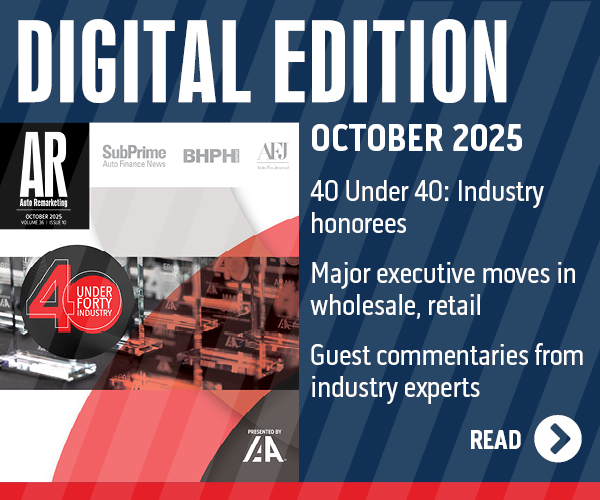Cox Automotive, Edmunds, J.D. Power and TrueCar all tried to sort through the static created by new- and used-vehicle supply constraints and rising prices to offer sales and other predictions for September, which closes on Thursday.
For dealers that do have plentiful used and new models to retail, perhaps this comment from Edmunds senior manager of insights Ivan Drury directed at consumers will help store managers and salespeople reach their monthly sales goals.
Read more
With the month’s end in sight, experts from Cox Automotive, J.D. Power and TrueCar shared their expectations for August used-vehicle and new-model sales as well as how wholesale prices and residual values are trending.
Beginning first with TrueCar’s used-vehicle sales forecast, analysts project dealers retailing 3.7 million units in August. While that’s roughly the same amount as July, the prediction represents a 6% lift from a year ago.
The projected rebound would reverse what the industry produced in July.
According to Cox Automotive estimates, total used-vehicle sales decreased 18% year over year in July. Analysts determined the seasonally adjusted annual rate (SAAR) of sales declined to 36.9 million, down significantly from 44.8 million last July, which they called “a strong used-vehicle sales month, the early days of the initial pandemic recovery.
Cox Automotive noted the July used SAAR also was down compared to 39.0 million in June.
Total used-vehicle sales volume last month was estimated at 3.1 million, down from 3.2 million in June, Cox Automotive added in an online Data Point.
What dealers are having to pay to obtain that used inventory continues to be a challenge that’s been intensified with potential buyers looking to the used department to satisfy their vehicle wishes because of low new-model selection. Jonathan Banks, vice president of valuations services at J.D. Power, addressed that part of the automotive landscape.
“In August, used vehicles continue to help fill the gaps on dealer lots left by low levels of new inventory. In the wholesale marketplace, dealers are competing fiercely for a finite amount of available used units which is ultimately helping keep wholesale prices near record levels,” Banks said.
“So far in August, wholesale prices for units up to eight years in age have been flat to up slightly, while overall wholesale sales are trending nearly 29% lower than during August 2019,” he continued.
“We still expect wholesale prices to gradually cool as the market moves into the fall, however, a certain degree of volatility should be expected as the industry continues to work through supply-related challenges,” Banks went on to say.
Continuing the used-vehicle conversation was Eric Lyman, who is senior vice president of ALG. Lyman tied together his latest observations on residual values with what’s happening on dealer blacktops nowadays.
“The recent cooling in the used market is more than just end of summer seasonality, it signals the start of an extended gradual decline in vehicle values that will play out over the next 18 months and bring residual values closer to pre-pandemic levels,” Lyman said.
“Fortunately, pent up demand, fewer late model year vehicles in the used supply chain and sustained, but tempered, economic recovery will result in residual values that will continue to be above historical norms,” he continued.
“ALG’s current full-year residual outlook for 2021 model-year vehicles returning in 2024 calendar year is 50.6% of MSRP. This is about one percentage point above the pre-pandemic average of 49.7% of actual 3-year-old retention from 2015-2019,” Lyman went on to say.
New-vehicle inventory insights
Thomas King, president of the data and analytics division at J.D. Power, said franchised dealers currently have about the same number of new vehicles on their lots in August as they did in July. King pegged the figure at approximately 942,000 vehicles in inventory available for retail sale, compared with roughly 3.0 million in inventory two years ago.
“Although inventory is arriving at dealers daily, it is simply replacing the vehicles being sold, preventing dealers from increasing inventories to a level necessary to support a higher sales pace. This means the sales pace is being dictated by production levels rather than actual consumer demand,” King said.
When new models are delivered to franchised dealers, J.D. Power pointed out that they sell quickly.
This month, J.D. Power indicated more than 49% of new vehicles will be sold within 10 days of arriving at a dealership, up from 47% in July and up from only 26% in August 2019.
J.D. Power also pointed out that the average number of days a new vehicle sits on a dealer lot before being sold is on pace to fall to a record low of 26 days, the first time on record below 30 days. That’s down from 62 days a year ago, and down four days from July.
King closed his thoughts by looking toward next month that starts with the traditional retail buzz during Labor Day weekend.
“Looking forward to September, the dynamics observed in August are expected to continue with sales being constrained by available inventory,” King said. “The key question is the extent to which manufacturers can produce enough vehicles to increase — rather than maintain — inventory levels.
“Ongoing supply chain issues and recent announcements of further production cuts by several manufacturers mean that the aggregate inventory situation is unlikely to meaningfully improve in September,” he continued. “In some instances, it will deteriorate. It also means that prices and per-unit profitability will remain strong.
“Shoppers accustomed to Labor Day promotional events with large discounts on outgoing model-year vehicles will likely be disappointed by the lack of discounts and choice of vehicles. But as August demonstrates, there are plenty of shoppers willing and able to buy at higher prices with less choice,” King went on to say.
New-model sales expectations
With the inventory situation being what it is, TrueCar predicted total new-vehicle sales will reach 1,212,399 units in August, down 4% from a year ago but up 1% versus July, when adjusted for the same number of selling days.
According to TrueCar, this month’s seasonally adjusted annualized rate (SAAR) for total light vehicle sales is an estimated 14.4 million, down 4% from August 2020.
Excluding fleet sales, TrueCar is predicting U.S. retail deliveries of new cars and light trucks to be 1,077,701 units, down 7% from a year ago and about even with July.
“The chip shortage continues to be the driving force behind vehicle availability, creating the lowest average incentive spending since 2013,” TrueCar lead industry analyst Nick Woolard said. “Continued strong demand is creating an environment where vehicles are selling extremely quickly. About a third of vehicles are selling within a week of arriving on the dealer lot, compared to just 18% last year.”
Valeri Tompkins, senior vice president of OEM solutions at TrueCar, added these thoughts.
“Though new-vehicle sales continue to decline in August, some brands saw a year-over-year increase in sales. Toyota is operating extremely well considering their inventory days’ supply is roughly half the industry average,” Tompkins said.
“We will continue to see how they perform once their announced plant closures put additional pressure on production and inventory,” she went on to say.
Cox Automotive is projecting new-car sales volume to finish near 1.20 million, down 9% from last August, which had one additional selling day, and down nearly 7% from last month.
Cox Automotive noted that August’s finish would be the fourth consecutive monthly decline of 500,000 units or more since April’s post-pandemic peak pace of 18.3 million.
The supply situation will likely worsen over the coming weeks, according to Cox Automotive senior economist Charlie Chesbrough.
“Available inventory on dealer lots has been falling for months, and sales have been constrained further and further as a result. And soon the market will enter the Labor Day holiday weekend, usually one of the highest sales periods of the entire year, but with half the supply they had last year,” Chesbrough said.
After falling more than 6% last year, look for the used-vehicle market to climb to 41 million sales this year.
That’s according to a forecast shared by Edmunds, which also detailed how pre-owned sales have fared over the last six years.
In 2019, used-car sales approached
Read more
Even as vehicle supply remains short and prices hit record highs, demand continues to surge in the used-car market.
TrueCar was forecasting that May’s retail used-vehicle would end up beating year-ago figures by 13% and besting April’s by 4%.
The firm is projecting that once final numbers are tallied …
Read more
Despite tight inventory, total used-vehicle sales in April were up 69% compared to April 2020, according to my colleague, Cox Automotive chief economist Jonathan Smoke, who is forecasting full-year retail used-vehicle sales will reach 21.5 million, an increase from 19.7 million in 2020.
At 60,000 strong, independent dealers are the backbone of our industry and a driving force in the auto market’s recovery. They account for nearly 70% of all wholesale auction purchases and more than half of retail used-vehicle sales.
The vital role of these dealers benefits both the wholesale and retail automotive sectors, as well as the overall economy and, ultimately, working-class consumers. They give franchise dealers an exit strategy for older or high-mileage trade-ins that don’t necessarily fit their inventory profile. They also provide needed access to affordable used vehicles in small, rural communities that lack the economies of scale to support a franchise dealership model.
Inventory constraints are a major pain point for the entire industry right now, and especially independents. With online auto retailers taking a larger share of the market, there is increased competition for the units offered at auction houses. As a result, franchised dealers and national retailers are buying older inventory in greater supply than they normally would.
Additionally, because of a lag in retail price increases, independent dealers have less inventory over which to spread their purchase gains and losses. When they can’t get their pricing right, they’re getting outbid on units they would normally win at the auction.
The good news is that, despite these challenges, the future looks bright. Cox Automotive projects retail volume for independent dealers will grow in the coming year and at a faster pace than franchised dealers, driven by an increasingly large inventory of used cars in the 4- to 9-year range. This is a space that independents have typically dominated, while franchise dealers tend to compete more heavily in the 0 to 3-year-old space.
It is truly a sweet spot for independents. These older used vehicles have aged out of the franchise model, but still has plenty of life left. They are also feature-rich, entering new to the market at a time when back-up cameras and other high-tech features were becoming more standard. As today’s consumers look for more value-conscious buys, the independent dealer stands to gain.
NextGear Capital is proud to support these entrepreneurial businesses as a wholesale financing partner to help them purchase affordable used car inventory. Serving more independent dealers than any other lender, we provided $17.3 billion in floor plan transaction financing for our clients in 2020.
Our commitment to the success of independent dealers is broad and steadfast. From offering credit lines with flexible terms and competitive pricing, to providing insights to help them make more informed decisions and investing in technologies to streamline their operations and create efficiencies, NextGear Capital is delivering solutions to reduce their pain points and help them thrive in any environment.
Scott Maybee is president of NextGear Capital, one of the largest independent inventory finance companies in North America, offering lines of credit and a robust array of services and support for dealers to acquire and sell new and used vehicles. Headquartered in Carmel, Ind., it is a Cox Automotive brand.
From a numbers standpoint, the outlook for used-car sales in March is a bright one. But the pre-owned market may not be immune to fallout from supply challenges currently facing the new-car market.
TrueCar is forecasting 3.6 million used-vehicle sales this month, which would beat February figures by 1% and eclipse year-ago numbers by 104%.
It is projecting 10.33 million used-car sales for the first quarter, which would beat year-ago figures (8.61 million) by 20%.
Granted, March 2020 was when COVID-19 was declared a pandemic, with lockdowns and businesses (including dealerships) forced to temporarily close.
So year-over-year comps of this magnitude are perhaps not surprising. Though speaking to the new-car market, TrueCar lead industry analyst Nick Woolard gives this context, which may help to put the used-car gain in perspective.
“The pandemic's dramatic impact on the automotive industry and U.S. economy at large began in the last two weeks of March 2020 when dealerships and OEM plants shut down and stay-at-home mandates rolled out, which gives us our first year-over-year sales compare,” Woolard said in a news release.
“Automotive sales dropped 38% from 2019, so it's no surprise that we're seeing total sales up 42% and retail sales up 53% when compared to the March 2020,” he said of the new-car market. “Looking at the year-over-year sales forecast, domestic brands such as GM and Ford, fared much better because parts of the country that hold a majority of trucks sales from these brands had not yet rolled out their state stay at home orders at this point last year.”
Still, as any baseball coach will tell you, a double is a double.
And pre-owned sales being more than twice as high as they were in March 2020 surely is a sign of strong used-car demand.
In fact, the new-car side of the market is seeing an “imbalance” of low supply and high demand, and that is spilling over into used, leading to a spike in pre-owned prices. In analysis that speaks largely to the new-car market, TrueCar senior vice president of OEM solutions Valeri Tompkins shares the used-car trickle-down effect.
“As consumers receive their stimulus checks and tax refunds, we expect demand for vehicles to increase. At the same time, production complications such as with microchips and shortages of other core materials are affecting a number of automakers, and retailers are struggling to have enough supply to meet the strong demand,” Tompkins said in a news release. “Consumers who are very specific about the vehicle they want to purchase may need to be extra patient, as they will likely have a harder time finding their first choice of color or trim when shopping.”
She added: “Vehicles are turning on dealer lots very quickly because of the supply and demand imbalance. In fact, according to TrueCar's new-car inventory data, the average vehicle is in inventory for only 56 days, which is two weeks less on the dealer lot than during this exact time last year.
“This is also causing the price of used vehicles to increase significantly year-over-year,” she said. “The average listing of the used vehicle on TrueCar is up $2,300 year-over-year, so if consumers are looking to sell their used vehicles, now is a great time.”
Supply-chain impacts like the microchip shortage are initially hitting the new-car market, obviously, but this could also have an effect on used inventory, as J.D. Power pointed out this week in an Industry Briefing Report authored by vice presidents Jonathan Banks and Tyson Jominy.
“As a result of these and other constantly shifting variables, automakers are in the process of prioritizing which vehicles they will bring to market,” their report said.
“Most American manufacturers will continue making relatively expensive trucks and SUVs because the profit margins are better than lower-priced sedans, and coupes. The trend will eventually affect what is available in the used-vehicle market as the year unfolds.”
In a mid-month reading of the Manheim Used Vehicle Value Index released last week, Cox Automotive said that used retail supply was at 34 days, according to a rolling seven-day estimate from vAuto data. That is softer than normal, the company said.
Similarly, Cox estimated wholesale used supply at 19 days, compared to the typical level of 23.
And wholesale prices continue to rise: The mid-month reading of Manheim's index was 175.5, beating March 2020 by 23.7%.
As previously reported by Auto Remarketing, dealers looking for things to cool off in the wholesale kitchen might be waiting a while based on the trio of observations Black Book offered in its latest weekly report.
“Auction sales rates, as a percentage of total offered for sale, continue to grow, with the only no-sales being the result of sellers’ unwillingness to budge on their desired pricing and buyers being hesitant due to current retail price levels,” analysts said.
“With the release of the newest round of federal stimulus into consumers’ bank accounts and the increase in demand it spurred on dealer lots, the expectation is that used demand will continue to be strong as those dealers look to replenish their inventory after a strong week of retail sales. With this knowledge, remarketers are continuing to push their floors higher each week,” they continued.
“Supply continues to be constricted as there is a reduction in rental units returning to the market, as well as trade-ins being kept by dealers and lease turn-ins being held by the grounding dealer instead of being sent to auction,” analysts went on to say.
Nick Zulovich contributed to this report.
Automakers are trimming car models from their new-vehicle lineups, and this has led to fewer and fewer affordable alternatives in a market where transaction prices reached record levels last month.
That, says Edmunds, “will create a barrier to entry for many consumers and force them into the used-car market.”
Perhaps to the tune of close to 500,000 shoppers, estimates Edmunds analyst Ivan Drury.
On Thursday, Edmunds shared several projections for 2021, one of which was that the new vehicles “will continue to grow more pricey and exclusive as the pandemic drives an income divide among Americans,” the company said in a news release.
In fact, the average price on a new vehicle last month was $40,753, a record high, Edmunds said. And it’s likely to continue rising, driven by increased demand for pricier trucks and SUVs.
“Edmunds analysts expect this number to go up as affluent consumers benefiting from lower interest rates and healthy stock and housing markets continue buying bigger, more expensive new trucks and SUVs,” the company said of December’s record.
This is likely to have a ripple effect on used cars, as many consumers are expected to be priced out of new vehicles, given the rising prices and lack of lower-cost alternatives.
In follow-up comments shared by Edmunds via email, Drury estimates a half-million consumers could turn from would-be new-car buyers to used-vehicle buyers.
His calculation is based on the 2014 sales volumes of models cut from automaker lineups for 2021, assuming a 6-year trade-in cycle, Edmunds said.
As for where the total sales are headed in the used-car market, Edmunds is forecasting 41 million this year, up from an estimated 38.3 million sales in 2020.
The company projects 15.5 million new-car sales in 2021, which would beat 2020 figures by 6.5%.
“2020 was an incredibly tumultuous year for the industry, but some unique market conditions helped retail sales end up in a much stronger place than anticipated, and the good news is that these should serve as some decent tailwinds into 2021,” said Jessica Caldwell, Edmunds’ executive director of insights, in a news release.
“Despite the economic hardships faced by so many Americans during the pandemic, there’s still a large population of well-off consumers who have been taking advantage of favorable financing conditions and sustaining healthy demand in the new-car market,” she said.
Edmunds is among the latest to share projections for new- and used-car sales in 2021. Within pre-owned, specifically, TrueCar is forecasting 40.05 million total used-car sales for this year.
Cox Automotive is projecting used sales will climb to 39.3 million this year and 40.2 million next year, before moving down slightly to 39.8 million in 2023.
Cox Automotive estimated that used-car retail sales (those involving a dealer) fell from 20.8 million in 2019 to 19.5 million last year.
But those used retail numbers are expected to climb to 21.2 million sales this year, 22.1 million in 2022 and 22.4 million in 2023.
After a downturn in 2020, the used-car market is expected to kick off a multi-year rebound in sales, with numbers expected to eclipse the 40 million mark in 2022, say analysts with Cox Automotive.
According to Friday's Cox Automotive Industry Insights 2021 presentation, there was an estimated 36.7 million total used-vehicle sales in 2020. While that’s down from 40 million in 2019, Cox Automotive is projecting used sales to climb to 39.3 million this year and 40.2 million next year, before moving down slightly to 39.8 million in 2023.
Cox Automotive estimated that used-car retail sales (those involving a dealer) fell from 20.8 million in 2019 to 19.5 million last year.
But those used retail numbers are expected to climb to 21.2 million sales this year, 22.1 million in 2022 and 22.4 million in 2023.
In Friday’s presentation, Cox Automotive manager of economic and industry insights Zo Rahim said that, “we have seen a recovery in the retail market; this is especially true of the used-vehicle market. It is important to keep in mind that the total used-vehicle market in the U.S. is two-and-a-half times the size of the new-vehicle market.
“It absolutely dominates the automotive landscape. We have seen the used market improve greatly from the lows back in April.”
The used-car market tends to be less volatile, Rahim said, therefore the pre-owned market declines are not as steep as those in new cars. And they tend to bounce back faster.
While last year showed declines, “we can expect continued recovery in the used-vehicle market as we navigate 2021 and beyond,” Rahim said.
One area of the used-car market that remains especially strong is the certified pre-owned segment.
While 2020 sales failed to extend the streak of record years, they were still close to recent highs and have shown considerable gains since the spring.
“Where we saw the biggest improvement from April was in the CPO market. In December, CPO sales declined 2% year-over-year and were up 24% month-over-month,” Rahim said. “CPO sales ended the year with 2.6 million units (sold), down 7% in 2020.
“Gently used and younger used vehicles should continue to see consumer interest this year.”
Used-vehicle sales for 2020 were expected to finish 6% softer than the final 2019 tally, but it appears the year at least closed on a positive note for pre-owned.
In a forecast released Dec. 28, TrueCar was projecting 3.1 million used-vehicle sales for December, which would beat November sales by 7% and prior-year figures by 6%.
That would put the final year-end total at a projected 38.4 million used sales for 2020, a 6% drop from 2019, according to TrueCar.
Separately, Cox Automotive analyst Kayla Reynolds said in an earlier December interview that 2020 was expected to close with 36.3 million used-car sales overall, with used retail (sales from dealers) at 19.3 million.
For 2021, it is expected that the used total will climb to 39.3 million.
On the new-car side, TrueCar was forecasting total sales of 14.6 million for full-year 2020, a 15% drop. For retail new-car sales, specifically, it was projecting 12.7 million, an 8% decline.
For December, in particular, TrueCar was projecting 1.61 million total new-car sales (a 6.5% year-over-year decrease, adjusting for selling days) and 1.43 million retail sales (down 2.2%).
“In the final days of 2020, we can finally look in the rearview mirror and appreciate the tremendous recovery that the automotive industry has made since the pandemic derailed auto sales in March. Retail vehicle sales have nearly reached normal levels with sales down only 2.2% from last year, which is a truly impressive outcome,” TrueCar director of OEM analytics Nick Woolard said in a news release.
“The momentum from a strong third quarter carried into the fourth quarter and solidified the industry’s comeback,” Woolard said. “Production and inventory have gone back up in the fourth quarter and, as a result, retail sales are up 34% quarter-over-quarter.”
You can expect November to finish with 3 million used-vehicle sales, according to the latest forecast from ALG and TrueCar, which would mark a 1% year-over-year decline.
The drop from October would be even more pronounced (11%).
In a
Data Point report released Nov. 18, Cox Automotive indicated that a 30-day period covering pieces of October and November had the lowest used-car sales since the beginning of May. Pre-owned sales for that fall stretch were off 18% year-over-year and 28% softer than the apex in late June.
Softer used sales were among factors driving higher supply, the company explained.
In the Data Point report, Cox Automotive senior economist Charlie Chesbrough said: “Used-vehicle supply is likely rising for a number of reasons. Higher prices for used vehicles are likely slowing sales. Plus, more trade-ins from improving new-vehicle sales are coming into the market along with ongoing off-lease vehicles. The combination of all of those factors are causing days’ supply to rise.”
Meantime, ALG and TrueCar project a 2.9% year-over-year jump in new-car retail sales (adjusted for selling days) for November. New sales are expected to beat October numbers by 8.4% and reach 1.10 million units.
“As Thanksgiving weekend and Black Friday inch closer, we anticipate the new-vehicle sales momentum from the past three months to continue with increases year-over-year for new retail sales,” ALG chief industry analyst Eric Lyman said in a news release.
“We expect many consumers who have not been financially affected by the pandemic to make their vehicle purchases this month, especially with fewer people traveling this holiday season and with inventory rebounding,” he said.
“Last year, the average discount on Black Friday was 10.2% off the manufacturer’s suggested retail price and we expect similar deals for this year,” Lyman said.












